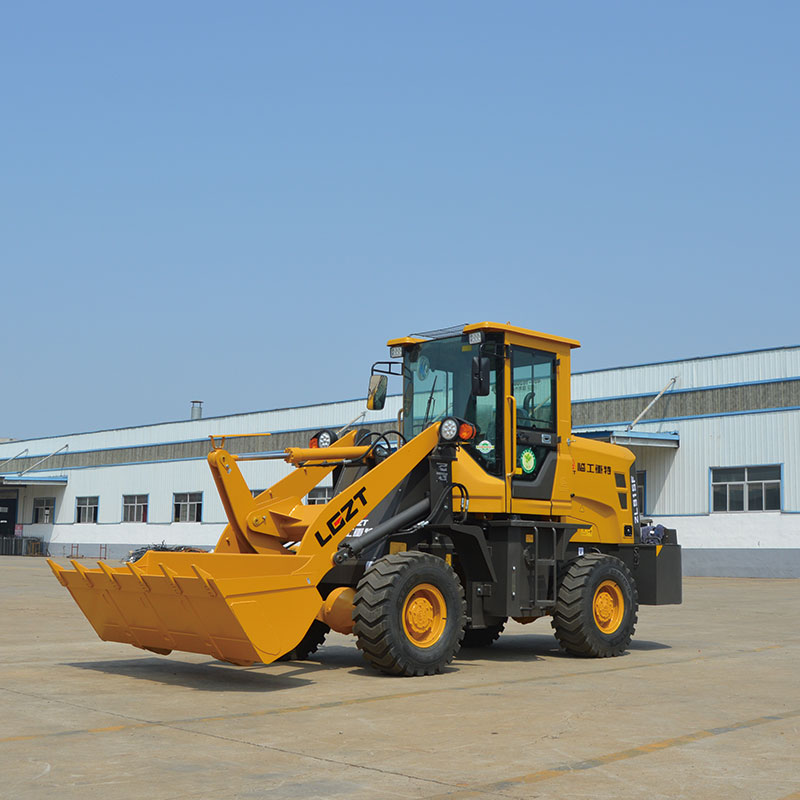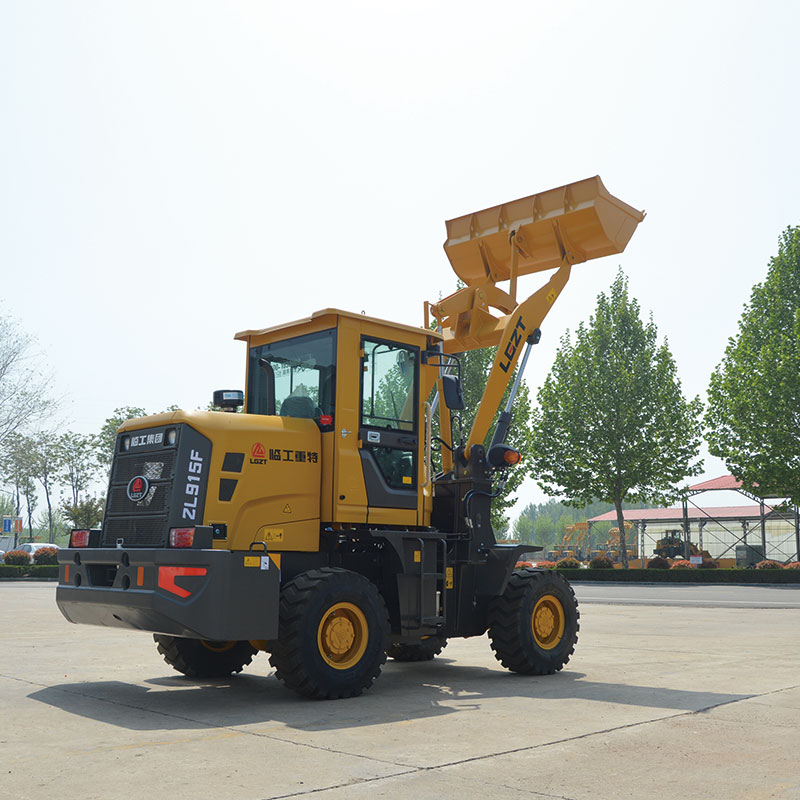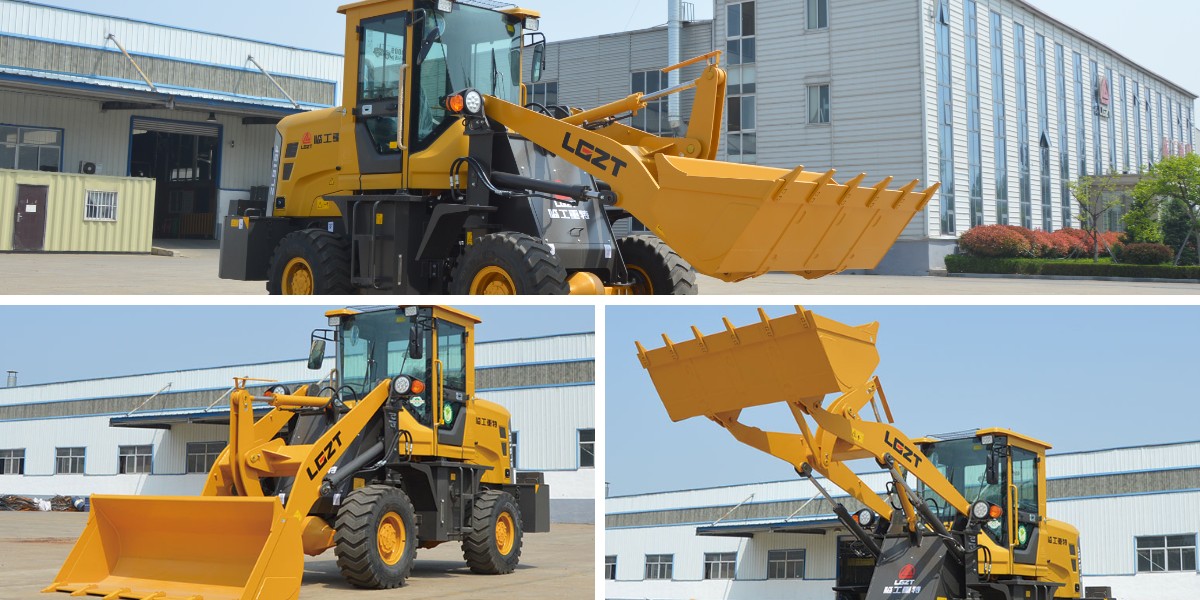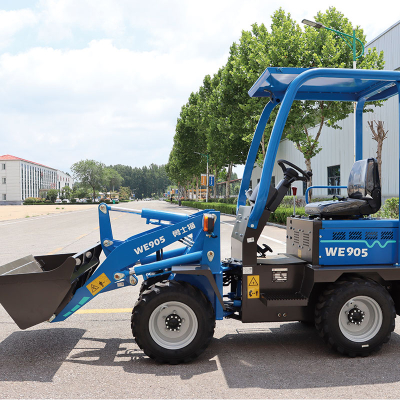Mini Payloader
ZL915F mini payloader
Structural design and durability
Operational safety and comfort
Environmental protection and ease of maintenance
Detailed Explanation of the Features of ZL915F mini payloader
As a crucial mechanical equipment in the field of engineering construction, the wheel loader plays an irreplaceable role in various engineering construction, material handling and other operations. Its characteristics demonstrate unique advantages in practical applications. The following will elaborate in detail on the features of wheel loaders.
1. Strong mobility and flexibility
Background introduction
In the fields of modern engineering construction and material handling, the working environment is complex and diverse, and one often faces the challenge of limited space. For instance, in ports, a large amount of goods need to be loaded, unloaded and transferred in a timely manner. The site is piled up with all kinds of goods and transportation tools, and the space available for the operation of loaders is relatively narrow. In urban construction sites, the surrounding buildings are dense, and the construction area is often restricted within a certain range. Loaders need to operate efficiently in such a limited space. The emergence of wheel loaders has well met the operational requirements in these special environments.
Detailed description of features
The wheel loader adopts a wheel chassis design, which brings it many advantages. It has all-wheel drive capability, which means that all four wheels can provide driving force. Just as four-wheel drive vehicles can better maintain power output in complex road conditions, the wheel loader can run stably in various terrain conditions.
Compared with crawler loaders, wheel loaders have more obvious advantages. During the operation of a crawler loader, the friction between the tracks and the ground is relatively large, which can easily cause damage to the road surface. Especially on the cement ground of some urban roads or ports, obvious marks will be left, affecting the service life of the road surface. The tires of wheel loaders cause minimal damage to the road surface and do not damage it, ensuring the integrity of the road. In addition, wheel loaders are not inferior in adapting to complex terrains. They can travel in various terrain conditions such as mud and sand, and can quickly achieve short-distance transfer. In urban construction sites, if the material loading in a certain construction area is completed and needs to be transferred to another area as soon as possible, the wheel loader can reach the destination quickly, greatly improving work efficiency.
Practical application cases and their impacts
Take ports as an example. Every day, a large number of containers and bulk cargo need to be loaded, unloaded and handled at ports. Wheel loaders move freely between the narrow passageways and cargo piles in the port. They can quickly load bulk cargo onto transport vehicles or move goods to designated locations. Its powerful mobility and flexibility make the cargo handling operations in the port more efficient, reduce the retention time of goods in the port, accelerate the turnover speed of goods, and improve the overall operational efficiency of the port. In urban construction sites, wheel loaders also play an important role. When the construction site needs to handle materials and level the site within the narrow construction area with numerous buildings, it can move easily between various construction points, providing a strong guarantee for the smooth progress of the project.
2. Modular multi-functional operation
Background information
With the continuous diversification of engineering construction demands, the functional requirements for loaders are also getting higher and higher. The traditional single-function loader can no longer meet the complex operation requirements of modern engineering. For instance, on some large construction sites, it is not only necessary to load and transport materials, but also to clean the site and crush hard objects, etc. To meet such diverse operational demands, wheel loaders have developed the feature of modular and multi-functional operation.
Specific analysis of features
One of the core features of a wheel loader is the realization of diverse functions through the quick replacement of accessories. It is equipped with a variety of different types of accessories, such as buckets, forks, sweepers, breakers, etc. The bucket is the most common accessory, used for loading various materials such as sand, gravel, soil, coal, etc. When it is necessary to transport these materials to the designated location, loading the bucket can complete the task like a hardworking "strongman". Forks are similar to the forks of a forklift. For some individual goods, such as wood and steel, using forks can facilitate transportation and stacking, just like a professional logistics mover. The sweeper is like a "little urban cleaner". It can be installed at the front end of the loader to quickly sweep away dust and debris on construction sites, roads and other ground surfaces, keeping the working environment clean and tidy. The breaker hammer is a "powerful tool" for dealing with hard objects. When encountering difficult-to-handle objects such as rocks and concrete, installing a breaker hammer transforms the wheel loader into a "mine crusher", breaking the hard objects into small pieces for easier subsequent processing.
The replacement of these accessories is very fast. Usually, only simple operations are needed to complete the replacement in a short time, which greatly improves the work efficiency. The working device driven by the hydraulic system of the wheel loader supports precise control. The hydraulic system is like the muscles and bones of the human body, capable of precisely controlling the movements of the accessories. When using a bucket for loading and unloading operations, the hydraulic system can precisely control the lifting, tilting and opening and closing of the bucket, just like a doctor can precisely control the scalpel during a delicate operation, ensuring the accuracy of the loading volume and the efficiency of the operation.
Advantage manifestation and application scenario expansion
In some large-scale comprehensive construction sites, the modular and multi-functional operation characteristics of wheel loaders have been fully exerted. In the early stage of construction, a bucket was used for site leveling and material excavation. During the early solid stage of the materials, when encountering some hard stones or concrete blocks, install a breaker to break them. In the later stage of site cleaning, the sweeper will be replaced and the construction site will be cleaned thoroughly. The realization of multiple functions of this single loader not only reduces the purchase cost of the equipment, but also saves the storage space of the equipment and improves the economic benefits of the construction unit. Meanwhile, in various industries such as logistics parks and mines, the modular and multi-functional operation of wheel loaders has also provided strong support for the development of each industry and expanded their application scenarios.
3. Efficient Power and Transmission System
Power Demand and Technological Development background
In engineering construction, wheel loaders need to handle various different workloads. For instance, when excavating hard rocks, strong force is required to break and load them. When handling large quantities of materials, a continuous and stable power output is required to ensure long-distance transportation. To meet these complex working requirements, the power and transmission systems of wheel loaders are constantly undergoing technological innovation and development.
System composition and working principle
Wheel loaders are usually equipped with diesel engines. Diesel engines are characterized by strong power and high torque, just like the engine of a large diesel truck, which can provide sufficient power for the loader. The energy generated by the combustion of diesel in a diesel engine is transferred to the transmission system through a series of mechanical conversions. The transmission system is usually composed of a hydraulic torque converter and a gearbox. The hydraulic torque converter is like an intelligent "power converter", which can automatically adjust the output torque and rotational speed according to the changes in the load. When a loader encounters heavy loads, such as loading a large amount of materials, the hydraulic torque converter will increase the output torque, just like an athlete pulling harder steps when climbing a slope, providing the loader with sufficient force to push the materials. When the load is small, the hydraulic torque converter will reduce the output torque and increase the rotational speed, enabling the loader to travel at high speed, just like an athlete running fast on a flat road.
The transmission is responsible for further regulating the power output. It can switch between different gears, just like the gears of a car, and select the appropriate gear according to different operational requirements. This combined transmission system can achieve stepless speed change, that is, within a certain range, the transmission ratio can be continuously adjusted, enabling the traveling speed and power output of the loader to change more smoothly. Some advanced models also adopt an electronic power management system, which is like a "power manager". It can monitor the working status and load conditions of the engine in real time, optimize fuel economy and enhance adaptability to complex working conditions based on the actual situation. When the engine operates under different loads, the electronic power management system will intelligently adjust parameters such as fuel injection volume and ignition time, ensuring that the engine always works in the best condition. This not only saves fuel but also improves the power output efficiency.
Economic benefits and industry impact
The efficient power and transmission system has brought significant economic benefits to wheel loaders. In terms of fuel consumption, due to the application of reasonable power regulation and electronic power management systems, the fuel efficiency of the loader has been greatly improved, reducing the usage cost. For construction enterprises, this means that a large amount of fuel costs can be saved during long-term operations. In terms of adaptability to complex working conditions, whether it is the harsh environment of mines or the ever-changing terrain of construction sites, wheel loaders can operate stably with their efficient power and transmission systems, ensuring the progress and quality of the project. This advanced technology has also promoted the development of the entire construction machinery industry, prompting more enterprises to increase their investment in research and development of power and transmission systems, and enhance the performance and competitiveness of their products.
4. Structural Design and Durability
Design intent and usage environment considerations
Wheel loaders have to deal with high-intensity work in engineering operations, such as long-term material loading and handling tasks. At the same time, they also need to adapt to various harsh working environments, such as dusty construction sites and damp mines. Therefore, its structural design must fully consider durability and stability to ensure long-term stable operation in complex environments.
Structural Feature Analysis
The frame of the wheel loader adopts an articulated split structure, which ingeniously balances steering flexibility and overall stability. The articulated structure enables the front and rear vehicle bodies to rotate relatively, achieving flexible steering, while the split structure ensures the strength and stability of the vehicle body. Just like a bridge, although it can move in the middle, the overall structure is still solid and reliable. During driving and operation, even when encountering uneven roads or centrifugal forces when turning, the articulated split structure can keep the loader stable and prevent accidents such as overturning.
Key components such as the bucket and boom are the parts of the wheel loader that directly participate in the operation. They are subjected to huge impact forces and frictional forces. To extend the service life of these components, the wheel loader is reinforced with thickened steel plates or wear-resistant materials. Thickened steel plates are like putting on a layer of "steel armor" for these components, enhancing their compressive resistance and wear resistance. Wear-resistant materials act like "super lubricants", reducing the friction between components and materials and lowering the degree of wear. For instance, in mining operations, buckets need to frequently dig rocks. Buckets that have undergone thickening and wear-resistant treatment can still maintain good performance during long-term use and will not be easily damaged.
The design of the hydraulic cylinder and connecting rod mechanism focuses on impact resistance. The hydraulic cylinder is like the joints of the human body, responsible for driving the movement of components such as the boom and bucket. During the operation, when the loader performs rapid lifting, telescopic and other actions, the hydraulic cylinder will be subjected to a great impact force. Therefore, the designers adopted high-strength materials and special structural designs during the design process, enabling it to withstand such impact forces. The connecting rod mechanism links all the components, playing a role in transmitting force and coordinating actions. Its shock-resistant design ensures that all components can work stably together under complex working conditions. Just like a precise mechanical clock, each part works in coordination with one another to jointly complete complex tasks.
The significance and practical effects of durability
The structural design and durability advantages of wheel loaders have been fully demonstrated in practical applications. In some long-term engineering projects, wheel loaders that have been carefully designed and strengthened can operate continuously for several years without the need for large-scale maintenance and component replacement, significantly reducing the equipment's usage cost and maintenance frequency. Construction enterprises can invest more funds in engineering construction to enhance economic benefits. Meanwhile, durability also ensures the smooth progress of the project, reduces the downtime caused by equipment failure, and improves the operational efficiency and project quality.
5. Operational Safety and Comfort
The background of the emergence of safety and comfort requirements
As people pay more and more attention to safe production and the occupational health of employees, wheel loaders, as important equipment in engineering operations, have received increasing attention for their operational safety and comfort. In the past, the operating conditions of loaders were rather harsh, and drivers had to endure considerable labor intensity and safety risks. The design of modern wheel loaders is precisely aimed at improving this situation and providing drivers with a safe and comfortable working environment.
The safety and comfort features are specifically presented
The wheel loader is equipped with a hydraulic control system with proportional pilot control. This system is like an intelligent assistant, which can precisely control the movements of the loader according to the driver's operating force and direction. Compared with the traditional mechanical control system, the hydraulic control system with proportional pilot control is more convenient to operate. The driver only needs to gently turn the steering wheel or move the control lever to easily control the steering, lifting, telescopic and other actions of the loader, greatly reducing the physical exertion during operation. Meanwhile, the precise control of this system has also enhanced the accuracy of operations and reduced the possibility of misoperation. Just like a precise navigation system, it guides the loader to accurately complete various tasks.
The cab pays attention to ergonomic design, which is the key to improving the driver's comfort. Ergonomic design is to design the layout and equipment of the cab based on the physiological and psychological characteristics of the human body. The seats in the cab are designed based on ergonomic principles, which can fit the driver's body curves and provide good support and comfort. Even after driving for a long time, one won't feel tired. It's as relaxing as sitting on a comfortable sofa at home. The layout of the dashboard is clear and reasonable. All kinds of indicator lights, instruments, etc. are within the driver's line of sight, which is convenient for the driver to quickly read the information.













